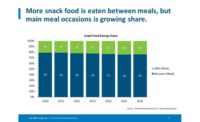Happy New Year! Can it really be 2014 already? Well, it is, and you need to get ready for an exciting year. After all, your input, hard work, drive and motivation are what make the baking and snack food industries what they are. And that means you need to do some research, homework, re-evaluating and looking at the big picture, which is what many of us do as one year ends and another begins.
For example, are you really—I mean really—watching what consumers eat? Do you consider what your customers’ customers (consumers) want in baked goods and snacks?
On any given day, approximately 11% of all eating occasions take place within one hour of purchasing food or beverages. This is according to a study published in August on immediate consumption occasions from research firm The Hartman Group.
The group has been tracking changes in American consumers’ food culture for more than 20 years. The group says consumer eating behavior continues to change and evolve in relation to shifting lifestyles that are dictated by all sorts of factors, such as work demands, commuting to and from work, raising families, social interaction, holidays, kids’ after-school and weekend activities and so much more. With these factors in mind, traditional views of mealtime can basically “be thrown out the window,” the group reports. The imprint of these dynamic cultural changes is the blurring of the boundaries between “snack” and “meal.”
America’s Changing Eating Habits syndicated research examines the cultural phenomenon of snacking, the rise of eating-alone eating occasions and immediate consumption of those foods and beverages consumed within an hour of purchase. The study explores the who, what, where, when and why of the foods and beverages purchased and consumed for each occasion as well as functional and emotional factors.
The eating habits research uncovered a key piece of information: Many food companies continue to market products to family occasions and iconic meals of the past and are missing out on new opportunities emerging from the dynamic changes taking place in American culture (in general) and our eating culture (specifically).
From sunup to sundown, and into the late-night hours, our eating patterns are changing to where eating now occurs anytime and anywhere. Did you know that snacking now accounts for 53% of all eating occasions in the U.S. (according to Hartman’s Eating Occasions Compass 2012)?
Why? The influence of food culture and changing demographics in this country are impacting eating habits. We’re snacking more, eating in greater isolation and definitely eating in-the-moment and on-the-go. My guess is that we’re so busy every day, we can’t help it.
For the majority of us, a “meal” today has been transformed into a constantly shifting assortment of snacking, eating alone and immediate consumption, according to the study.
So what else is driving this change in behavior? Lack of time, work overload (we editors can certainly relate), emotions and an opportunity for an indulgent treat are often the motivators, as are boredom, feeling off balance or tired, needing a stress reliever and enjoying something with a close friend, loved one or other intimate person.
And when consumers find what they’re looking for and the label reads, “contains genetically modified ingredients,” they pay two-thirds less or decline to buy the product altogether, says a recent Cornell study on shopping behavior. When the label reads, “partially hydrogenated oils,” consumers want all the gory details, even the information on the cholesterol in the contents and heart disease. So don’t dumb-down the end user of your products. When provided with more information about ingredients, they’re more confident about deciding to purchase and value the product more, the Cornell research says.




